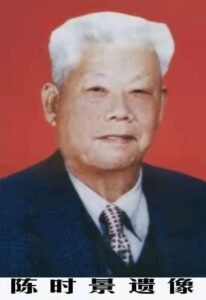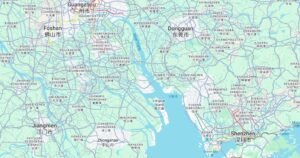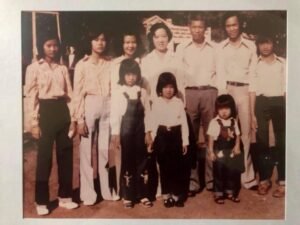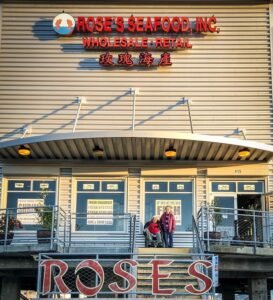A fishmonger from Vietnam.

The title of this story is misleading since Canh Thoi Tran (1930-2021) was actually born in Foshan, China. He was married in Vietnam in 1950 to Tien T. Quach (19xx-). His nine children were born and raised in South Vietnam where he lived for thirty years until the aftermath of the war forced them to emigrate in 1979. A summary of the genealogy of the Tran family is here.
Foshan and Guangzhou.
Foshan is a river port city in Guangdong Province (Chinese: “Eastern Reaches”) 16 km (10 mi) from Guangzhou (“Canton”). Part of the Pearl River Delta (Mandarin pinyin: “Zhujiang”), Guangdong is a region of low hills crossed by numerous rivers that empty into the South China Sea through an estuary whose mouth is flanked by Hong Kong to the north and Macau to the south. Its climate is humid tropical and subtropical, and annual rainfall ranges from 60 to 80 inches (1,500 to 2,000 mm). The vast majority of China’s sugarcane is grown in Guangdong.
Guangdong is physically separated from the Yangtze River basin by the Nan Mountains. It was originally populated by non-Han ethnic groups who placed importance on lineage and ancestry. This is often reflected in the settlement pattern, with the inhabitants of many villages belonging exclusively to one or two lineages. After its conquest by the Chinese empire in 222 BC, the military and agricultural colonisation of Guangdong was very slow.
As a result of internal migrations in the following centuries, the population of Guandong grew very rapidly. In the late 17th century, the region experienced a rapid increase in emigration to Southeast Asia and North America, including some purchased laborers for the British, French and Dutch colonies.
The name Foshan means “Buddha Mountain” and comes from the three bronze statues of Buddha unearthed by villagers in 622 AD.
Foshan: From fishing village to trade hub.
Because of Guangdong’s long coastline and numerous ports, fishing and fish farming in ponds and streams have historically accounted for more than one-third of local income and provided about one-fifth of the fish consumed in China.
Situated in the center of a productive, highly populated plain with excellent river communications, Foshan was already an immigration and emigration route and a port with its own customs in the 17th century, exporting ceramics and silk from Guangzhou.
Foshan specialized in handicrafts and the manufacture of silk threads and textiles, as well as embroidery and dyeing. It became famous for its official robes and the emperor’s silk clothes.
Dutch trading post in the 17th century.

“Faesan” (Foshan), Embassy of the Dutch East India Company to the Emperor of China. Johan Nieuhof,1665.
In the 18th century, Foshan had more than 100,000 households, six markets, more than 20 bridges and 60 ferries.
In 2020, Foshan City was a prefecture capital about 16 km from Guangzhou City. Foshan includes 21 towns and more than 300 villages with a total population of 9.5 million and an annual per capita GDP of US$19,699. More recently, due to the establishment of industrial development and export trade zones such as Shenzhen and the absorption of Hong Kong, the population of Guangdong Province has increased to more than 126 million.

River access to Foshan by Hong Kong and Macau.
C.T.´s Childhood in Foshan.
C.T. came from a poor family living in a rural village.
From an early age, C.T. had to work to help his family and he had no formal education.
The family supplemented their income by purchasing merchandise in Canton and other large cities, to sell in their village.
Canton (Guangdong) was the birthplace of prominent political, military and intellectual leaders. Between 1939 and 1945, Chiang Kai-shek began his efforts in Guangzhou against the communist movement and the Japanese occupation of southern Guangdong. After World War II, the civil war between communists and nationalists ended with a communist victory in late 1949.
C.T. taken to Vietnam.
In 1947, when he was 17, C.T. Tran was sold to work in South Vietnam. He kept in touch with his family and helped them financially.
Three years after arriving in Vietnam, C.T. had bought his freedom and achieved great success in Vietnam’s coffee business. He owned one of the largest coffee companies.
In 1950, at the age of twenty, he proposed and was able to marry Tien T. Quach, who came from a traditional family from South Vietnam.

Difficulties in Vietnam.
In 1978, C.T. and T.Q. had nine children. They lived in South Vietnam and C.T. operated his coffee business with great success.
His older daughters were engaged and the extended family was growing.

In March 1973, after two decades of civil war in Vietnam, American troops, who had supported the South, left the country. Communists in the North took over the South and formed the Socialist Republic of Vietnam in July 1976. Repression and the regime’s takeover of private enterprises made daily life dangerous and business unsustainable.
As this story was being written, a family member recounted his horrific memories of the war during his teenage years and then spending several months in jail as a private businessman accused of plotting to escape from Vietnam.
By 1978, having lost all his businesses to the new regime, C.T. realized that the life he wanted for his children would not be possible in Vietnam and began making careful plans to leave with his entire family.
Family Sails to Hong Kong.
In 1979, most families escaping Vietnam were sailing south to Malaysia and Thailand. C.T. decided to head north to Hong Kong, then a British colony.
Upon arrival in Hong Kong, they were housed in disused military barracks and allowed to work as laborers in the city, being transported back each night to sleep with their families in the barracks.
Family Sails to the United States.
In 1979, merchant ships charged about a thousand dollars per person or its equivalent in gold bullion.
After several weeks of sailing, the Tran family landed in the Gulf of Texas.
C.T. Starts a seafood business in Texas.
Determined to make a living and take care of his family, Canh T. Tran would go out fishing for shrimp early in the morning and then later in the day, sell them on the streets of downtown Houston.
During this difficult adjustment period, the entire family collaborated in the fledgling family business.


Success.
By 2014, after 35 years of re-starting in Texas, C.T., with the support of his wife and family, had created a group of wholesale and retail companies with national seafood distribution based in Seabrook, Texas Gulf.


Grateful in their new homeland.
Gratitude.
Canh T. Tran donated the funds to build a school in his hometown in China. He wanted to ensure that children would have the opportunity to receive a free education and have better opportunities than he did.


Upon learning of his death in 2020, the school that C. T. had donated in China paid tribute to his memory as shown in the photo. The image of the portrait used in that ceremony, heads this story.


Acknowledgement and Sources.
Most of the information has been compiled from interviews conducted by Angel N. T. with the help of her grandmother T. Quach, her aunts Tran-Quach and from the obituary of C.T. We hope someday to complete details and make contact with the Chinese relatives of C.T. Tran and the Vietnamese relatives of Tien T. Quach.